Digital Twin of Space Environment: Development, Challenges, Applications, and Future Outlook
Abstract
:1. Introduction
1.1. Research Questions
- SQ1: What are the main technical challenges of using digital twins in the space environment?
- SQ2: How to deal with data transmission delays, model accuracy, and user interface design?
- SQ3: How does the application of digital twins in space contribute to efficiency and safety in mission planning, astronaut training, and deep space exploration?
- SQ4: How will the convergence of advanced technologies such as artificial intelligence and machine learning with digital twins change the face of space exploration in the future?
1.2. Contributions
- Comprehensive perspective of digital twins in space environment: For the first time, this paper systematically evaluates the application potential of digital twins in the space environment, which is not only limited to spacecraft design and maintenance but also covers astronaut training, space station operation, deep space exploration, and other dimensions, presenting a comprehensive and in-depth understanding framework for readers;
- In-depth analysis of technical challenges and solutions: Through detailed case studies and theoretical discussions, we identify and analyze the unique challenges faced by digital twins in the application of space technology, including data transmission delays, model accuracy improvement, and user interface optimization, and propose corresponding solutions;
- Future application direction and technology integration outlook: We not only reviewed the past and current technological progress but also boldly predicted the future trend of digital twin technology and artificial intelligence, machine learning, augmented reality, and other emerging technologies integration, pointing out the direction for researchers and decision-makers.
2. Development of Digital Twins in Space Environments
2.1. Requirements and Challenges of Digitalization in Space Environments
2.2. Fundamental Concepts of Digital Twins in Space Environments
- (1)
- State estimation and prediction algorithm: Kalman filter, particle filter, and other technologies are used to estimate the current state of physical entities and predict future behavior;
- (2)
- Fault detection and diagnosis algorithm: Through pattern recognition, machine learning, and other methods to identify abnormal behavior, timely detection of potential faults;
- (3)
- Optimization and control algorithms: Based on physical models and real-time data, optimize the performance of physical entities, such as fuel consumption, orbit adjustment, etc.
2.3. Application Cases of Digital Twins of Space Environments
3. Key Technologies and Challenges
3.1. Key Technologies in System Construction and Management
3.1.1. Physical Entity to Virtual Model Mapping
- (1)
- High-Precision 3D Modeling Technology: This is fundamental for constructing virtual models. It requires precise digital representation of the geometric shape, structural layout, and material properties of space assets. This typically involves advanced Computer-Aided Design (CAD) tools and 3D scanning technologies to ensure geometric accuracy and richness of details;
- (2)
- Simulation of Complex Physical Fields: The complexity of space environments demands that virtual models can simulate interactions among various physical fields such as electromagnetic, thermal, and mechanical fields. Multiphysics simulation engines integrate these different physical processes, providing a unified simulation platform for modeling complex phenomena in space, such as the effects of solar wind on satellite surfaces and temperature changes on material performance;
- (3)
- Parametric Modeling Technology: This allows models to automatically adjust their structure and performance based on changes in input parameters. This technology is particularly important in design optimization, sensitivity analysis, and uncertainty quantification. Through parametric modeling, researchers can evaluate the performance of space assets under different design variables and operating conditions, providing a scientific basis for design decisions;
- (4)
- Rigorous Verification and Calibration: To ensure the accuracy and reliability of virtual models, they must undergo stringent verification and calibration. This includes comparisons with actual measurement data, analysis of model prediction uncertainties, and adjustment of model parameters. The verification and calibration process is iterative, ensuring that models accurately reflect the behavior of physical entities and provide a solid foundation for subsequent data analysis and decision-making.
3.1.2. Information Systems and Data Storage
- Software Architecture: The design of software architecture modularizes the various functional modules of the information system into independent services. These services communicate through well-defined interfaces and contracts, allowing for flexible combination and reuse. In space environments, Service-Oriented Architecture (SOA) supports cross-system service integration, enabling various task planning, monitoring, and analysis services to collaborate effectively, thereby enhancing the system’s responsiveness and adaptability [76,77,78].
- Communication Middleware Platforms: These platforms typically feature capabilities such as messaging, data transformation, and service orchestration. In digital twin systems for space, Enterprise Service Buses (ESB) are commonly used as the core for service integration, ensuring correct routing and processing of data from various sources and formats [79,80]. Furthermore, ESB supports the dynamic discovery and binding of services, ensuring the system’s scalability and flexibility.
- Microservice Architecture: This architecture involves breaking down an application into a set of small, independent services, each designed around a specific business function. This setup allows services to be independently deployed, scaled, and updated, thus enhancing the system’s reliability and maintainability. In space environments, microservice architecture aids in the rapid iteration and deployment of new functionalities to meet the evolving needs of missions [81,82].
3.1.3. Operations and Management in a Space Environment
3.2. Technical Challenges
3.2.1. Model Accuracy and Reliability
3.2.2. Data Collection and Transmission
3.2.3. System Interaction and Interface Design
4. Potential Applications and Development Prospects
4.1. Environmental Monitoring and Sustainable Development
4.1.1. Space Environment Monitoring and Prediction
4.1.2. Space Debris Tracking and Management
- (1)
- High-Precision Debris Modeling: The digital twin system constructs high-precision 3D models of space debris by integrating data from ground-based radars, optical telescopes, and other sensors. These models include the size, shape, and mass distribution of the debris, as well as its motion state in orbit, such as velocity, acceleration, and direction;
- (2)
- Debris Trajectory Prediction: Using physical laws and advanced numerical simulation methods, the digital twin system can predict the future motion trajectories of space debris. This prediction is crucial for assessing the potential collision risks with in-orbit assets and helps in planning avoidance strategies in advance;
- (3)
- Collision Risk Assessment: Through the simulation and analysis of debris trajectories, the digital twin system can assess the probability of collision and the potential impacts. This assessment takes into account the physical characteristics of the debris and the protective capabilities of space assets, as well as the distribution of debris clouds post-collision;
- (4)
- Avoidance Strategy Formulation: Once high-risk debris is identified, the digital twin system can assist in formulating effective avoidance strategies. This may include adjusting the orbital parameters of satellites, changing the timing of astronaut extravehicular activities, or replanning the sequence of space mission executions;
- (5)
- Debris Mitigation Measures: In addition to avoidance strategies, the digital twin system can support the development and evaluation of measures to mitigate the impact of space debris. This includes designing impact-resistant satellite structures, deploying protective barriers, and developing debris removal technologies;
- (6)
- Long-Term Monitoring and Database Construction: The digital twin system supports long-term monitoring of space debris, continuously updating the debris database to provide real-time data support for space debris management. These databases are valuable for the establishment of a global space debris monitoring network and international cooperation.
4.2. Mission Planning and Decision Support
4.2.1. Scientific Data Analysis and Decision Support
4.2.2. Satellite Navigation and Orbit Optimization
4.3. Safety and Emergency Operations
4.3.1. Space Asset Maintenance and Fault Diagnosis
4.3.2. Space Environment Simulation and Emergency Operation
- (1)
- Theoretical training module: This module uses MR Technology to allow trainees to view and interact with 3D objects through virtual reality equipment to learn about the different systems and operating procedures of the International Space Station (ISS). This module is based on European Space Agency (ESA) training courses and covers theoretical knowledge ranging from Newton’s laws to Kepler’s laws, as well as detailed information about the ISS such as the Zvezda service module, Zarya module, node module, and laboratory module;
- (2)
- Emergency simulation: In the second module, trainees are faced with a space debris collision crisis occurring inside the ISS. In this virtual scenario, trainees must apply Hohmann’s knowledge of transfer and circular motion to take action to avoid collisions by interacting with the ISS’s digital twin of propulsion, navigation, and emergency response systems. The scenario also includes the use of a return capsule, where trainees need to be transferred if an unavoidable collision is detected;
- (3)
- Spacewalk mission: Another practical scenario involves a spacewalk in which trainees are required to perform three tasks: repair an air leak, replace a battery, and recover a sample from a robotic arm. To accomplish these tasks, trainees must become familiar with the module structure and external view of the ISS, all through interaction with the digital twin;
- (4)
- Launch and Ascent Simulation: The third module focuses on preparing astronauts for space launch by simulating the launch and ascent of SpaceX’s Falcon Heavy rocket to familiarize trainees with the procedures associated with it. The scene uses Falcon Heavy 3D models and includes digital twins of propulsion, navigation, and staging systems.
5. Conclusions
- Data transmission latency and bandwidth limitations: Between Earth and space assets, data transmission faces significant latency and limited bandwidth. This is essential for real-time control and feedback, but it becomes a big problem in space missions that are far from Earth;
- Model accuracy and reliability: Building high-precision digital twins requires accurate physical modeling and sufficient real-world data. In the space environment, models must take into account extreme conditions such as microgravity, high radiation, temperature fluctuations, and vacuum effects, which adds to the complexity of modeling;
- Hardware and sensor reliability: High-precision sensors and hardware components need to maintain stability and reliability in the extreme conditions of space, which is critical for data accuracy and system functionality. Sensor failure or performance degradation will directly affect the utility of the digital twin;
- Data security and privacy: Implementing a digital twin means the generation and transmission of large amounts of data, including sensitive astronaut health data and critical system operation parameters. Ensuring the security and privacy of these data is a major challenge;
- System integration and interoperability: Digital twins require seamless integration with existing space assets, communications networks, and ground control centers. Ensuring interoperability and compatibility between different systems is a complex engineering task;
- Cost and resources: Implementing digital twin technology requires significant initial investment in research and development, hardware deployment, and maintenance. In the long term, continuous data processing and analysis also consume many resources.
Author Contributions
Funding
Acknowledgments
Conflicts of Interest
References
- Grieves, M. Digital Twin: Manufacturing Excellence through Virtual Factory Replication. White paper. (2015). Available online: https://www.researchgate.net/publication/275211047 (accessed on 1 March 2015).
- Allen, B.D. Digital Twins and Living Models at NASA. NASA Technical Reports Server. Available online: https://ntrs.nasa.gov/citations/20210023699 (accessed on 1 November 2021).
- Qi, Q.; Tao, F.; Zhang, M. Digital twin and big data towards smart manufacturing and Industry 4.0: 360-degree comparison. IEEE Access 2018, 6, 3585–3593. [Google Scholar] [CrossRef]
- Madni, A.M.; Madni, C.C.; Lucero, S.D. Leveraging digital twin technology in model-based systems engineering. Systems 2019, 7, 7. [Google Scholar] [CrossRef]
- Tuegel, E.J.; Ingraffea, A.R.; Eason, T.G.; Spottswood, S.M. Reengineering aircraft structural life prediction using a digital twin. Int. J. Aerosp. Eng. 2011, 2011, 154798. [Google Scholar] [CrossRef]
- Tao, F.; Zhang, M.; Liu, Y.; Nee, A.Y.C. Digital Twin in Industry: State-of-the-Art. IEEE Trans. Ind. Inform. 2019, 15, 2405–2415. [Google Scholar] [CrossRef]
- Tao, F.; Qi, Q. Make more digital twins. Nature 2019, 573, 490–491. [Google Scholar] [CrossRef] [PubMed]
- Fuller, A.; Fan, Z.; Day, C.; Barlow, C. Digital twin: Enabling technologies, challenges, and open research. IEEE Access 2020, 8, 108952–108971. [Google Scholar] [CrossRef]
- Rathore, M.M.; Shah, S.A.; Shukla, D.; Bentafat, E.; Bakiras, S. The role of ai, machine learning, and big data in digital twinning: A systematic literature review, challenges, and opportunities. IEEE Access 2021, 9, 32030–32052. [Google Scholar] [CrossRef]
- Groshev, M.; Guimarães, C.; Martín-Pérez, J. Toward intelligent cyber-physical systems: Digital twin meets artificial intelligence. IEEE Commun. Mag. 2021, 59, 14–20. [Google Scholar] [CrossRef]
- Mozo, A.; Karamchandani, A.; Gómez-Canaval, S. B5GEMINI: AI-driven network digital twin. Sensors 2022, 22, 4106. [Google Scholar] [CrossRef]
- Kaur, M.J.; Mishra, V.P.; Maheshwari, P. The convergence of digital twin, IoT, and machine learning: Transforming data into action. In Digital Twin Technologies and Smart Cities; Springer: Cham, Switzerland, 2020; pp. 3–17. [Google Scholar]
- Min, Q.; Lu, Y.; Liu, Z. Machine learning based digital twin framework for production optimization in petrochemical industry. Int. J. Inf. Manag. 2019, 49, 502–519. [Google Scholar] [CrossRef]
- Alexopoulos, K.; Nikolakis, N.; Chryssolouris, G. Digital twin-driven supervised machine learning for the development of artificial intelligence applications in manufacturing. Int. J. Comput. Integr. Manuf. 2020, 33, 429–439. [Google Scholar] [CrossRef]
- Lebjioui, S.; Kaba Traoré, M.; Ducq, Y. Digital Twin-Driven Design: A Framework to Enhance System Interoperability in the Era of Industry 4.0. In Enterprise Interoperability IX; Archimède, B., Ed.; Proceedings of the I-ESA Conferences 10; Springer Nature Switzerland AG: Cham, Switzerland, 2023; pp. 125–133. [Google Scholar] [CrossRef]
- Stergiou, C.L.; Psannis, K.E. Digital twin intelligent system for industrial IoT-based big data management and analysis in cloud. Virtual Real. Intell. Hardw. 2022, 4, 279–291. [Google Scholar] [CrossRef]
- Li, X.; Feng, M.; Ran, Y. Big Data in Earth system science and progress towards a digital twin. Nat. Rev. Earth Environ. 2023, 4, 319–332. [Google Scholar] [CrossRef]
- El Hassani, I.; El Mazgualdi, C. A Deep-Reinforcement-Learning-Based Digital Twin for Manufacturing Process Optimization. Systems 2024, 12, 38. [Google Scholar] [CrossRef]
- Zhang, Q.; Liu, Z.; Duan, J.; Qin, J. A Novel Method of Digital Twin-Based Manufacturing Process State Modeling and Incremental Anomaly Detection. Machines 2023, 11, 151. [Google Scholar] [CrossRef]
- Bofill, J.; Abisado, M.; Villaverde, J.; Sampedro, G.A. Exploring Digital Twin-Based Fault Monitoring: Challenges and Opportunities. Sensors 2023, 23, 7087. [Google Scholar] [CrossRef]
- Zhang, W.; Zhong, R.Y.; Huang, G.Q. Digital twin-driven production progress prediction for discrete manufacturing enterprises. Comput. Ind. Eng. 2019, 135, 1234–1245. [Google Scholar]
- GE Digital Introduces a Digital Twin Solution to Autonomously Tune Gas Turbines. Control.com. Available online: https://control.com/news/ge-digital-introduces-a-digital-twin-solution-to-autonomously-tune-gas-turbines (accessed on 9 February 2022).
- Bhatti, G.; Mohan, H.; Singh, R.R. Towards the future of smart electric vehicles: Digital twin technology. Renew. Sustain. Energy Rev. 2021, 141, 110801. [Google Scholar] [CrossRef]
- Hu, Z.; Lou, S.; Xing, Y. Review and perspectives on driver digital twin and its enabling technologies for intelligent vehicles. IEEE Trans. Intell. Veh. 2022, 7, 417–440. [Google Scholar] [CrossRef]
- Wang, Z.; Liao, X.; Zhao, X. A digital twin paradigm: Vehicle-to-cloud based advanced driver assistance systems. In Proceedings of the 2020 IEEE 91st Vehicular Technology Conference (VTC2020-Spring), Antwerp, Belgium, 25–28 May 2020; pp. 1–6. [Google Scholar]
- Kamel Boulos, M.N.; Zhang, P. Digital twins: From personalised medicine to precision public health. J. Pers. Med. 2021, 11, 745. [Google Scholar] [CrossRef]
- Sun, T.; He, X.; Li, Z. Digital twin in healthcare: Recent updates and challenges. Digit. Health 2023, 9, 20552076221149651. [Google Scholar] [CrossRef] [PubMed]
- Björnsson, B.; Borrebaeck, C.; Elander, N. Digital twins to personalize medicine. Genome Med. 2020, 12, 4. [Google Scholar] [CrossRef] [PubMed]
- Granacher, J.; Nguyen, T.V.; Castro-Amoedo, R. Overcoming decision paralysis—A digital twin for decision making in energy system design. Appl. Energy 2022, 306, 117954. [Google Scholar] [CrossRef]
- Huang, W.; Zhang, Y.; Zeng, W. Development and application of digital twin technology for integrated regional energy systems in smart cities. Sustain. Comput. Inform. Syst. 2022, 36, 100781. [Google Scholar] [CrossRef]
- ODwyer, E.; Pan, I.; Charlesworth, R. Integration of an energy management tool and digital twin for coordination and control of multi-vector smart energy systems. Sustain. Cities Soc. 2020, 62, 102412. [Google Scholar] [CrossRef]
- Shahat, E.; Hyun, C.T.; Yeom, C. City digital twin potentials: A review and research agenda. Sustainability 2021, 13, 3386. [Google Scholar] [CrossRef]
- Deng, T.; Zhang, K.; Shen, Z.J.M. A systematic review of a digital twin city: A new pattern of urban governance toward smart cities. J. Manag. Sci. Eng. 2021, 6, 125–134. [Google Scholar] [CrossRef]
- Lu, Q.; Parlikad, A.K.; Woodall, P. Developing a digital twin at building and city levels: Case study of West Cambridge campus. J. Manag. Eng. 2020, 36, 05020004. [Google Scholar] [CrossRef]
- Wang, L. Application and development prospect of digital twin technology in aerospace. IFAC-Pap. OnLine 2020, 53, 732–737. [Google Scholar]
- Li, L.; Aslam, S.; Wileman, A. Digital twin in aerospace industry: A gentle introduction. IEEE Access 2021, 10, 9543–9562. [Google Scholar] [CrossRef]
- Phanden, R.K.; Sharma, P.; Dubey, A. A review on simulation in digital twin for aerospace, manufacturing and robotics. Mater. Today Proc. 2021, 38, 174–178. [Google Scholar] [CrossRef]
- Ye, Y.; Yang, Q.; Yang, F. Digital twin for the structural health management of reusable spacecraft: A case study. Eng. Fract. Mech. 2020, 234, 107076. [Google Scholar] [CrossRef]
- Lo, C.K.; Chen, C.H.; Zhong, R.Y. A review of digital twin in product design and development. Adv. Eng. Inform. 2021, 48, 101297. [Google Scholar] [CrossRef]
- Tao, F.; Sui, F.; Liu, A. Digital twin-driven product design framework. Int. J. Prod. Res. 2019, 57, 3935–3953. [Google Scholar] [CrossRef]
- Tao, F.; Cheng, J.; Qi, Q. Digital twin-driven product design, manufacturing and service with big data. Int. J. Adv. Manuf. Technol. 2018, 94, 3563–3576. [Google Scholar] [CrossRef]
- Havard, V.; Jeanne, B.; Lacomblez, M.; Baudry, D. Digital twin and virtual reality: A co-simulation environment for design and assessment of industrial workstations. Prod. Manuf. Res. 2019, 7, 472–489. [Google Scholar] [CrossRef]
- Amati, L.; O’Brien, P.T.; Götz, D. The THESEUS space mission: Science goals, requirements and mission concept. Exp. Astron. 2021, 52, 183–218. [Google Scholar] [CrossRef]
- Viscio, M.A.; Viola, N.; Fusaro, R. Methodology for requirements definition of complex space missions and systems. Acta Astronaut. 2015, 114, 79–92. [Google Scholar] [CrossRef]
- Koons, H.C.; Mazur, J.E.; Selesnick, R.S. The Impact of the Space Environment on Space Systems; NASA STI/Recon Technical Report N; Aerospace Corporation: El Segundo, CA, USA, 1999; pp. 69036–69041. [Google Scholar]
- Lu, Y.; Shao, Q.; Yue, H. A review of the space environment effects on spacecraft in different orbits. IEEE Access 2019, 7, 93473–93488. [Google Scholar] [CrossRef]
- Piñal, O.; Arguelles, A. Mixed reality and digital twins for astronaut training. Acta Astronaut. 2024, 219, 376–391. [Google Scholar] [CrossRef]
- Shangguan, D.; Chen, L.; Ding, J. A digital twin-based approach for the fault diagnosis and health monitoring of a complex satellite system. Symmetry 2020, 12, 1307. [Google Scholar] [CrossRef]
- Curlin, P.S.; Muniz, M.A.; Bell, M.M. Virtual Reality Digital Twin and Environment for Troubleshooting Lunar-based Infrastructure Assembly Failures. arXiv 2022, arXiv:2203.02810. [Google Scholar]
- Hu, W.; Zhang, T.; Deng, X. Digital twin: A state-of-the-art review of its enabling technologies, applications and challenges. J. Intell. Manuf. Spec. Equip. 2021, 2, 1–34. [Google Scholar] [CrossRef]
- Botín-Sanabria, D.M.; Mihaita, A.S.; Peimbert-García, R.E. Digital twin technology challenges and applications: A comprehensive review. Remote Sens. 2022, 14, 1335. [Google Scholar] [CrossRef]
- Rasheed, A.; San, O.; Kvamsdal, T. Digital twin: Values, challenges and enablers from a modeling perspective. IEEE Access 2020, 8, 21980–22012. [Google Scholar] [CrossRef]
- Almasan, P.; Ferriol-Galmés, M.; Paillisse, J. Digital twin network: Opportunities and challenges. arXiv 2022, arXiv:2201.01144. [Google Scholar]
- Liu, M.; Fang, S.; Dong, H. Review of digital twin about concepts, technologies, and industrial applications. J. Manuf. Syst. 2021, 58, 346–361. [Google Scholar] [CrossRef]
- Melesse, T.Y.; Di Pasquale, V.; Riemma, S. Digital twin models in industrial operations: A systematic literature review. Procedia Manuf. 2020, 42, 267–272. [Google Scholar] [CrossRef]
- Jiang, Y.; Yin, S.; Li, K. Industrial applications of digital twins. Philos. Trans. R. Soc. A 2021, 379, 20200360. [Google Scholar] [CrossRef]
- Melesse, T.Y.; Di Pasquale, V.; Riemma, S. Digital Twin models in industrial operations: State-of-the-art and future research directions. IET Collab. Intell. Manuf. 2021, 3, 37–47. [Google Scholar] [CrossRef]
- Grieves M, W. PLM--beyond lean manufacturing. Manuf. Eng. 2003, 130, 23. [Google Scholar]
- Shafto, M.; Conroy, M.; Doyle, R. Modeling, Simulation, Information Technology & Processing Roadmap; National Aeronautics and Space Administration: Washington, DC, USA, 2010; pp. 5–7.
- Francisco, A.; Mohammadi, N.; Taylor, J.E. Smart city digital twin–enabled energy management: Toward real-time urban building energy benchmarking. J. Manag. Eng. 2020, 36, 04019045. [Google Scholar] [CrossRef]
- Angin, P.; Anisi, M.H.; Göksel, F. Agrilora: A digital twin framework for smart agriculture. J. Wirel. Mob. Netw. Ubiquitous Comput. Dependable Appl. 2020, 11, 77–96. [Google Scholar]
- Ghandar, A.; Ahmed, A.; Zulfiqar, S. A decision support system for urban agriculture using digital twin: A case study with aquaponics. IEEE Access 2021, 9, 35691–35708. [Google Scholar] [CrossRef]
- Wang, Z.; Jia, W.; Wang, K. Digital twins supported equipment maintenance model in intelligent water conservancy. Comput. Electr. Eng. 2022, 101, 108033. [Google Scholar] [CrossRef]
- Holt, S. Virtual reality, augmented reality and mixed reality: For astronaut mental health; and space tourism, education and outreach. Acta Astronaut. 2023, 203, 436–446. [Google Scholar] [CrossRef]
- Yang, W.; Zheng, Y.; Li, S. Application Status and Prospect of Digital Twin for On-Orbit Spacecraft. IEEE Access 2021, 9, 106499. [Google Scholar] [CrossRef]
- Pinello, L.; Brancato, L.; Giglio, M.; Cadini, F.; De Luca, G.F. Enhancing Planetary Exploration through Digital Twins: A Tool for Virtual Prototyping and HUMS Design. Aerospace 2024, 11, 73. [Google Scholar] [CrossRef]
- Maiwald, V.; Bauerfeind, M.; Fälker, S.; Westphal, B.; Bach, C. Feasibility of SpaceX’s Human Exploration Mars Mission Scenario with Starship. Sci. Rep. 2024, 14, 11804. [Google Scholar] [CrossRef]
- Medina, A.; Tomassini, A.; Suatoni, M.; Avilés, M.; Solway, N.; Coxhill, I.; Paraskevas, I.S.; Rekleitis, G.; Papadopoulos, E.; Krenn, R. Towards a standardized grasping and refuelling on-orbit servicing for GEO spacecraft. Acta Astronaut. 2017, 134, 1–10. [Google Scholar] [CrossRef]
- Callsen, S.; Wilken, J.; Stappert, S.; Sippel, M. Feasible options for point-to-point passenger transport with rocket propelled reusable launch vehicles. Acta Astronaut. 2023, 212, 100–110. [Google Scholar] [CrossRef]
- Jiang, H.; Qin, S.; Fu, J. How to model and implement connections between physical and virtual models for digital twin application. J. Manuf. Syst. 2021, 58, 36–51. [Google Scholar] [CrossRef]
- Zheng, Y.; Yang, S.; Cheng, H. An application framework of digital twin and its case study. J. Ambient Intell. Humaniz. Comput. 2019, 10, 1141–1153. [Google Scholar] [CrossRef]
- Sun, L.; Pei, A.; Qi, X. Dynamic analysis of digital twin system based on five-dimensional model. J. Phys. Conf. Ser. IOP Publ. 2020, 1486, 072038. [Google Scholar] [CrossRef]
- Zhang, M.; Tao, F.; Huang, B. Digital twin data: Methods and key technologies. Digit. Twin 2022, 1, 2. [Google Scholar] [CrossRef]
- Hausmann, M.; Koch, Y.; Kirchner, E. Managing the uncertainty in data-acquisition by in situ measurements: A review and evaluation of sensing machine element-approaches in the context of digital twins. Int. J. Prod. Lifecycle Manag. 2021, 13, 48–65. [Google Scholar] [CrossRef]
- Jones, D.; Snider, C.; Nassehi, A. Characterising the Digital Twin: A systematic literature review. CIRP J. Manuf. Sci. Technol. 2020, 29, 36–52. [Google Scholar] [CrossRef]
- Son, Y.H.; Park, K.T.; Lee, D. Digital twin–based cyber-physical system for automotive body production lines. Int. J. Adv. Manuf. Technol. 2021, 115, 291–310. [Google Scholar] [CrossRef]
- Schnicke, F.; Kuhn, T.; Antonino, P.O. Enabling industry 4.0 service-oriented architecture through digital twins. In Software Architecture: 14th European Conference, ECSA 2020 Tracks and Workshops, L’Aquila, Italy, 14–18 September 2020; Proceedings 14; Springer International Publishing: Cham, Switzerland, 2020; pp. 490–503. [Google Scholar]
- Park, K.T.; Lee, J.; Kim, H.J. Digital twin-based cyber physical production system architectural framework for personalized production. Int. J. Adv. Manuf. Technol. 2020, 106, 1787–1810. [Google Scholar] [CrossRef]
- Wang, Z.; Zou, W.; Wang, W. Credibility Evaluation Software Design for Digital Twin Systems of Spacecraft Agencies. In International Workshop of Advanced Manufacturing and Automation; Springer Nature: Singapore, 2023; pp. 100–110. [Google Scholar]
- Brenner, B.; Hummel, V. Digital twin as enabler for an innovative digital shopfloor management system in the ESB Logistics Learning Factory at Reutlingen-University. Procedia Manuf. 2017, 9, 198–205. [Google Scholar] [CrossRef]
- Ouahabi, N.; Chebak, A.; Zegrari, M. A distributed digital twin architecture for shop floor monitoring based on edge-cloud collaboration. In Proceedings of the 2021 Third International Conference on Transportation and Smart Technologies (TST), Tangier, Morocco, 27–28 May 2021; IEEE: Piscataway, NJ, USA; pp. 72–78. [Google Scholar]
- Bécue, A.; Maia, E.; Feeken, L. A new concept of digital twin supporting optimization and resilience of factories of the future. Appl. Sci. 2020, 10, 4482. [Google Scholar] [CrossRef]
- Maier, D.; Stein, J.; Otis, A. Development of an object-oriented DBMS. ACM Sigplan Not. 1986, 21, 472–482. [Google Scholar] [CrossRef]
- Stonebraker, M.; Abadi, D.J.; Batkin, A. C-store: A column-oriented DBMS. In Making Databases Work: The Pragmatic Wisdom of Michael Stonebraker; Association for Computing Machinery and Morgan & Claypool: New York, NY, USA, 2018; pp. 491–518. [Google Scholar]
- Carey, M.J.; DeWitt, D.J.; Graefe, G. The EXODUS extensible DBMS project: An overview. In Readings in Object-Oriented Database Systems; Morgan Kaufmann Publishers Inc.: San Francisco, CA, USA, 1988. [Google Scholar]
- Ester, M.; Frommelt, A.; Kriegel, H.P. Spatial data mining: Database primitives, algorithms and efficient DBMS support. Data Min. Knowl. Discov. 2000, 4, 193–216. [Google Scholar] [CrossRef]
- Peres, T.R.; Silva, J.S.; Silva, P.F. Multi-gnss receiver for aerospace navigation and positioning applications. Int. Arch. Photogramm. Remote Sens. Spat. Inf. Sci. 2014, 40, 87–92. [Google Scholar] [CrossRef]
- Groves P, D. Principles of GNSS, inertial, and multisensor integrated navigation systems. IEEE Aerosp. Electron. Syst. Mag. 2015, 30, 26–27. [Google Scholar] [CrossRef]
- Capuano, V.; Harvard, A.; Chung, S.J. On-board cooperative spacecraft relative navigation fusing GNSS with vision. Prog. Aerosp. Sci. 2022, 128, 100761. [Google Scholar] [CrossRef]
- Wright, L.; Davidson, S. How to tell the difference between a model and a digital twin. Adv. Model. Simul. Eng. Sci. 2020, 7, 1–13. [Google Scholar] [CrossRef]
- Zhang, L.; Zhou, L.; Horn B K, P. Building a right digital twin with model engineering. J. Manuf. Syst. 2021, 59, 151–164. [Google Scholar] [CrossRef]
- Tao, F.; Xiao, B.; Qi, Q. Digital twin modeling. J. Manuf. Syst. 2022, 64, 372–389. [Google Scholar] [CrossRef]
- Legai, P. Optimizing Collection, Transmission, and Transformation of Space Data to Take up Security Challenges, Toward Improved Crisis Prevention and Response. In Space Data Management; Springer Nature: Singapore, 2024; pp. 127–139. [Google Scholar]
- Kodheli, O.; Lagunas, E.; Maturo, N. Satellite communications in the new space era: A survey and future challenges. IEEE Commun. Surv. Tutor. 2020, 23, 70–109. [Google Scholar] [CrossRef]
- Kaushal, H.; Kaddoum, G. Optical communication in space: Challenges and mitigation techniques. IEEE Commun. Surv. Tutor. 2016, 19, 57–96. [Google Scholar] [CrossRef]
- Palazhchenko, Y.; Shendryk, V.; Shendryk, S. Digital Twins Data Visualization Methods. Problems of Human Interaction: A Review. In New Technologies, Development and Application VI, Proceedings of the International Conference “New Technologies, Development and Applications”; Springer Nature: Cham, Switzerland, 2023; pp. 478–485. [Google Scholar]
- Barricelli, B.R.; Fogli, D. Digital twins in human-computer interaction: A systematic review. Int. J. Hum.–Comput. Interact. 2024, 40, 79–97. [Google Scholar] [CrossRef]
- Jia, W.; Wang, W.; Zhang, Z. From simple digital twin to complex digital twin Part I: A novel modeling method for multi-scale and multi-scenario digital twin. Adv. Eng. Inform. 2022, 53, 101706. [Google Scholar] [CrossRef]




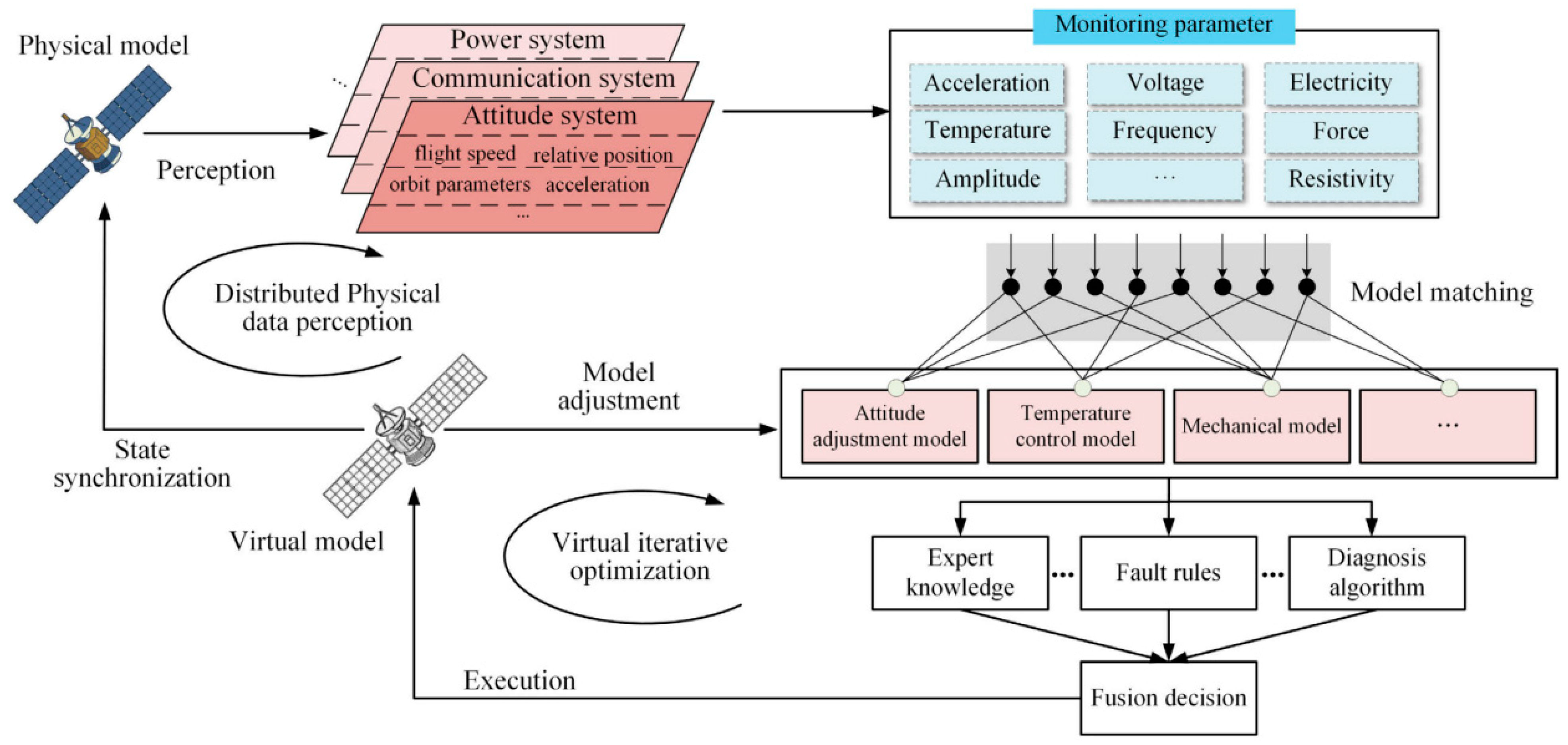


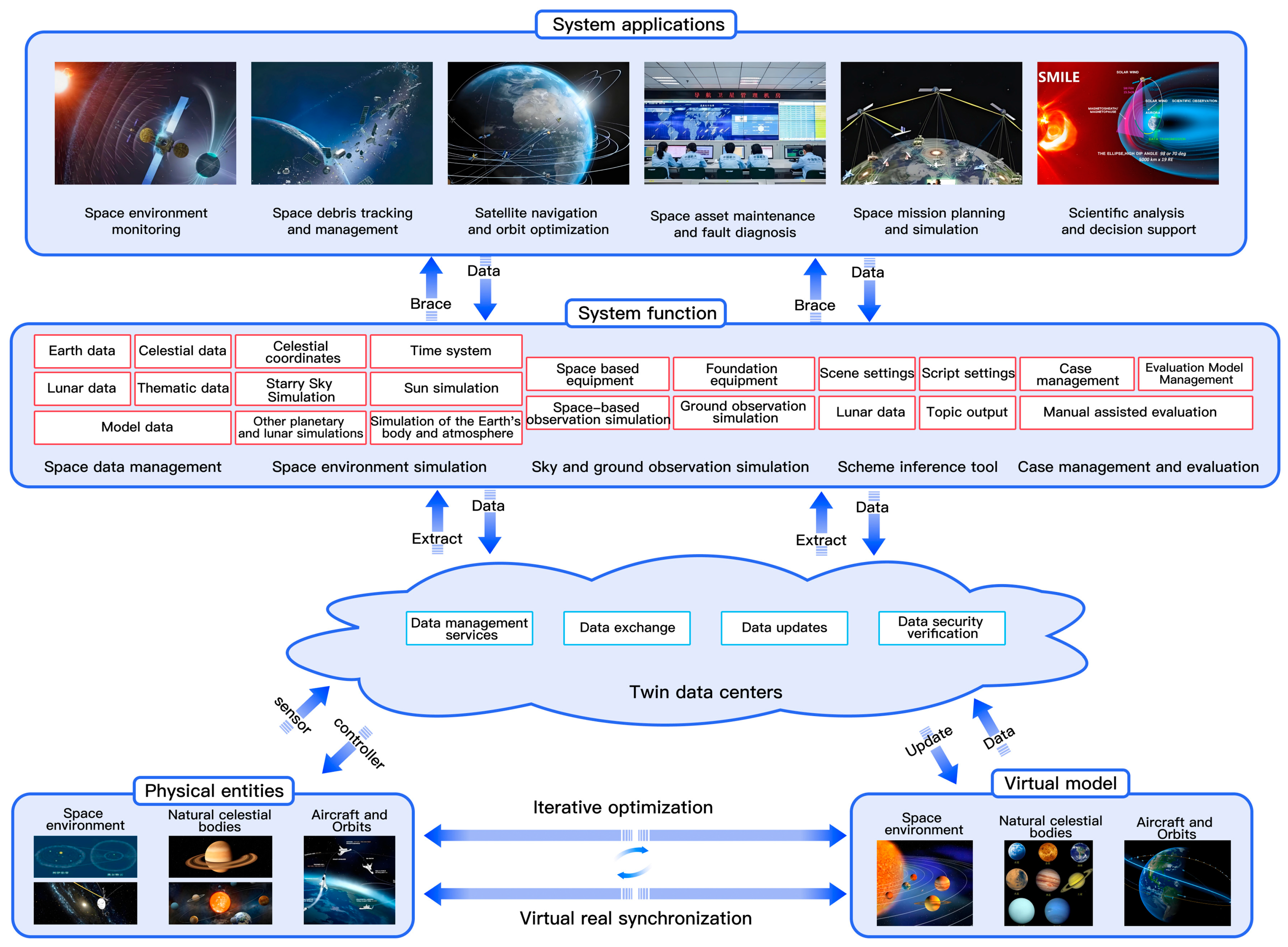
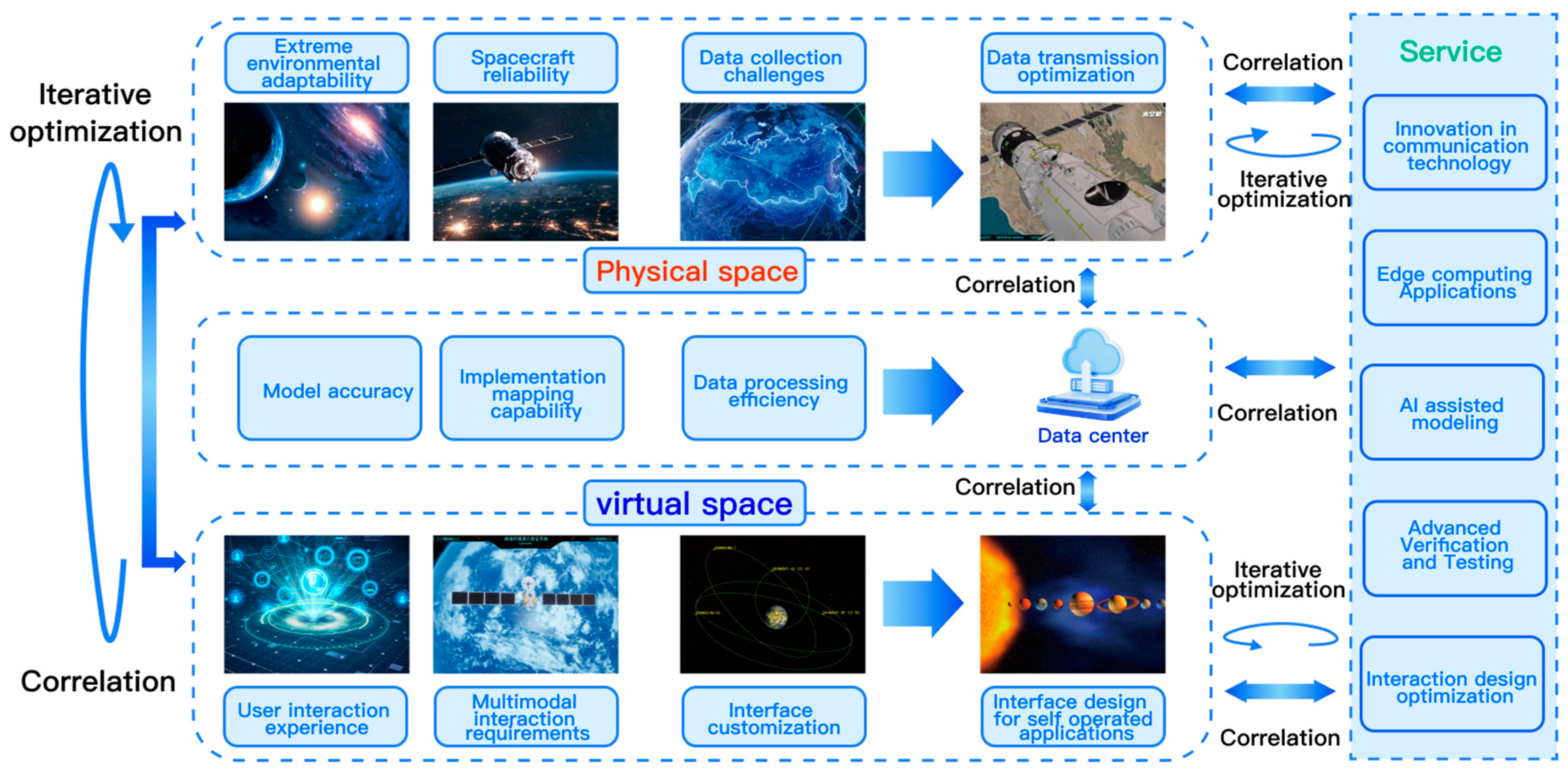
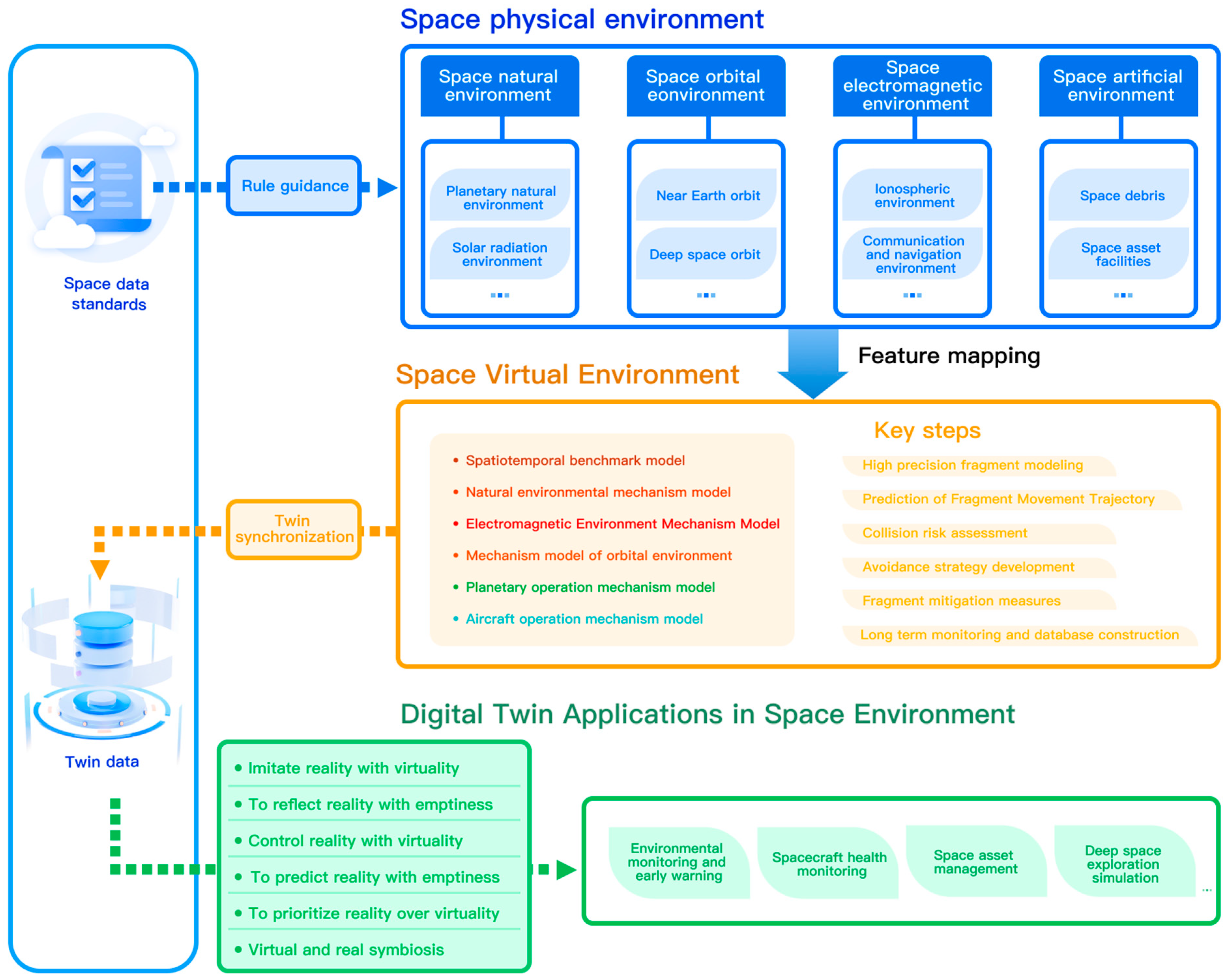
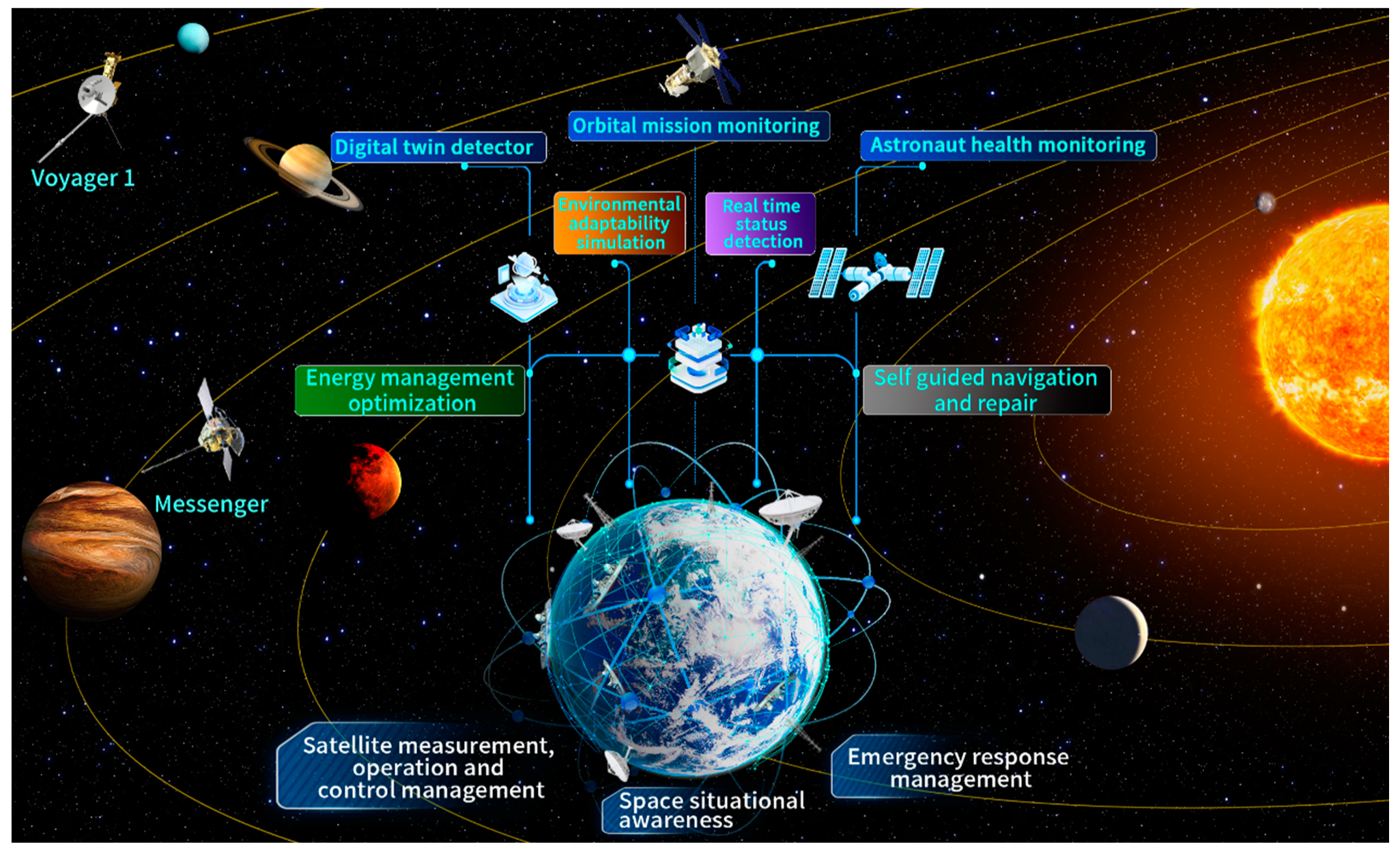
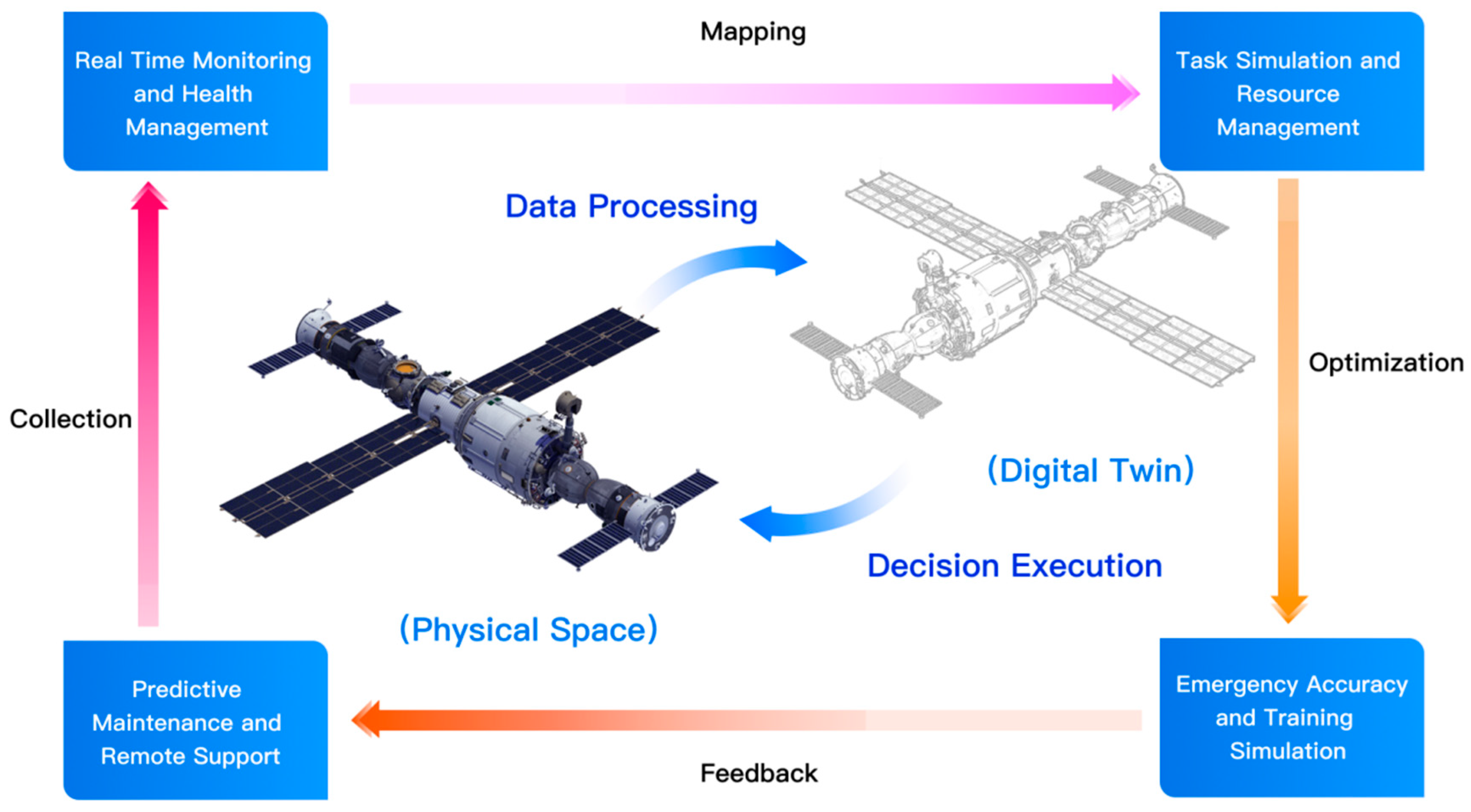
| NASA | National Aeronautics and Space Administration (U.S.) | IoT | Internet of Things |
|---|---|---|---|
| AI | Artificial Intelligence | ML | Machine Learning |
| GE | General Electric | RQ | Research Question |
| SQx | Sub-questions | AR | Augmented Reality |
| MR | Mixed Reality | VR | Virtual Reality |
| PLM | Product Lifecycle Management | AFRL | Air Force Research Laboratory |
| HUMS | Health and Usage Monitoring System | EKF | Extended Kalman Filter |
| LMO | Low Mars Orbit | ESA | European Space Agency |
| GEO | Geostationary Orbit | GAC | German Aerospace Center |
| SOA | Service-Oriented Architecture | ESB | Enterprise Service Buses |
| GNSS | Global Navigation Satellite Systems | FEA | Finite Element Analysis |
| CFD | Computational Fluid Dynamics | GUIs | User Interfaces |
| No. | Application Field | Key Indicators | Application Case Description |
|---|---|---|---|
| 1 | Astronaut training [47,64] | High-fidelity, mission-execution simulation | The digital twin simulates the space environment and astronauts’ missions, providing a ground training environment. |
| 2 | Aircraft health management [65] | Condition monitoring, life prediction, health management | By building a virtual mapping of each component, subsystem, and even the overall status of the spacecraft in virtual space, it is possible to conduct real-time maintenance and performance monitoring of the spacecraft throughout its life cycle. |
| 3 | Space exploration rover [66] | Design iteration speed, cost-effectiveness, accuracy | It integrates complex geometry, kinematics, and dynamics models, as well as sensors and control systems, to accurately simulate real-world exploration scenarios. |
| 4 | Interstellar shuttle digital twin [67] | Design and test the environmental adaptability of the aircraft | From preliminary design to operational performance in extreme space conditions, it enables engineers to anticipate and resolve potential problems without actually building and testing a full prototype. |
| 5 | European Space Agency’s spacecraft-servicing robot [68] | Mission planning and simulation to ensure safe space operations | Spacecraft maintenance robots use digital twin technology for mission planning and simulation to ensure that complex space operations can be performed safely and efficiently. |
| 6 | Digital twin of reusable rocket [69] | Multiple launch mission process simulations to accelerate design iterations | Digital twin technology is introduced to simulate the multiple launch processes of reusable rockets to optimize the rocket design and improve reuse efficiency. |
Disclaimer/Publisher’s Note: The statements, opinions and data contained in all publications are solely those of the individual author(s) and contributor(s) and not of MDPI and/or the editor(s). MDPI and/or the editor(s) disclaim responsibility for any injury to people or property resulting from any ideas, methods, instructions or products referred to in the content. |
© 2024 by the authors. Licensee MDPI, Basel, Switzerland. This article is an open access article distributed under the terms and conditions of the Creative Commons Attribution (CC BY) license (https://creativecommons.org/licenses/by/4.0/).
Share and Cite
Liu, W.; Wu, M.; Wan, G.; Xu, M. Digital Twin of Space Environment: Development, Challenges, Applications, and Future Outlook. Remote Sens. 2024, 16, 3023. https://doi.org/10.3390/rs16163023
Liu W, Wu M, Wan G, Xu M. Digital Twin of Space Environment: Development, Challenges, Applications, and Future Outlook. Remote Sensing. 2024; 16(16):3023. https://doi.org/10.3390/rs16163023
Chicago/Turabian StyleLiu, Wei, Mengwei Wu, Gang Wan, and Minyi Xu. 2024. "Digital Twin of Space Environment: Development, Challenges, Applications, and Future Outlook" Remote Sensing 16, no. 16: 3023. https://doi.org/10.3390/rs16163023







